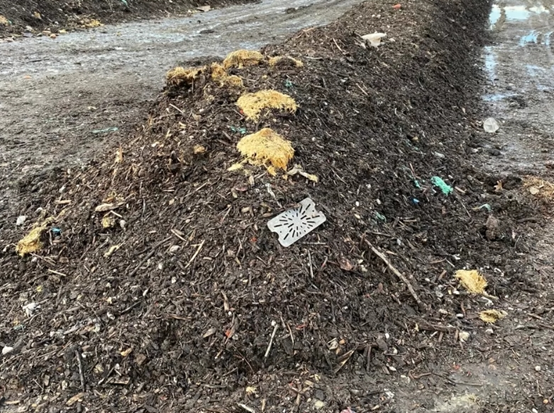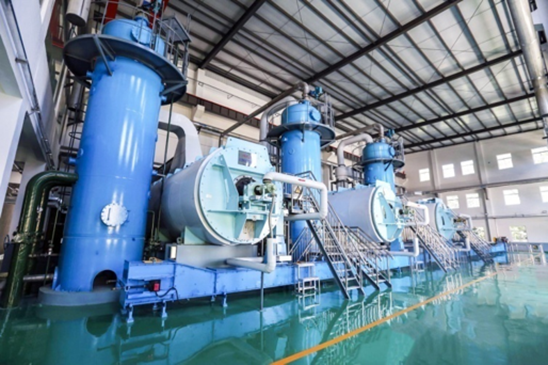

BLOG
Analysis of the Current Development Status and Pattern of the Global Sludge Treatment Industry in 2025
Analysis of the Current Development Status and Pattern of the Global Sludge Treatment Industry in 2025
28 October 2025

I. Total Volume and Structure: Rigid Growth and Regional Differentiation of Global Sludge Generation
In 2025, the global annual sludge output has exceeded 280 million tons, with municipal and industrial sources showing differentiated growth trends. Among them, municipal sludge accounts for approximately 62%, mainly driven by the general improvement in sewage treatment rates. The municipal sewage treatment rate in developed countries has reached over 95%, while emerging markets such as Southeast Asia and the Middle East have maintained an average annual growth rate of more than 7%, becoming the core driving force behind the growth of sludge generation.
Industrial sludge, on the other hand, exhibits high value-added characteristics. Organic sludge from industries such as petrochemicals, papermaking, and palm oil processing, as well as heavy metal-containing sludge from fields like electroplating and electronics, account for over 40% of the profit margin in the global sludge treatment market due to their high treatment difficulty and significant resource utilization potential.
In terms of regional distribution, China, with 35% of the global share, has become the world's largest sludge-producing country. The annual sludge output of county-level cities alone exceeds 30 million tons, and the treatment gap in townships and villages continues to widen. Europe's annual sludge output remains stable at around 42 million tons, but the demand for resource-based treatment is strong, with per capita investment in sludge treatment reaching 2.3 times the global average. The North American market focuses on the specialized treatment of industrial sludge; the sludge treatment market scale of the U.S. petrochemical industry alone reaches 6.8 billion U.S. dollars. Notably, the Southeast Asian market is in a period of explosive growth in facility construction, with investment in sludge treatment facilities in countries such as Vietnam and Indonesia increasing by over 27% year-on-year in 2025, making it a key area for international enterprises to deploy.
II. Policies and Standards: Differentiated Regulatory Systems Under Global Collaborative Stringency
In 2025, global sludge treatment policies have formed a dual-core orientation of "carbon constraints + resource utilization", and different economies have established differentiated regulatory frameworks based on their development stages. The European Union, through the Circular Economy Action Plan 2030 and the revised Urban Wastewater Treatment Directive, has clearly required member states to reduce the sludge landfill rate to below 10% by 2030, while incorporating phosphorus recovery into mandatory standards. Countries such as the Netherlands and Germany have achieved over 90% phosphorus recovery from sludge ash. The implementation of the Carbon Border Adjustment Mechanism (CBAM) has further incorporated the carbon footprint of sludge treatment into trade accounting systems, forcing enterprises to adopt low-carbon technical routes.
China's policy system features "full-process management and control". Specialized policies issued intensively between 2024 and 2025 have integrated sludge into the closed-loop management of urban sewage treatment. The new version of the Pollution Control Standard for Sludge Treatment has added 11 heavy metal limits, and pilot projects for "zero-waste cities" have been promoted to increase the resource utilization rate to 45%. The coverage rate of facilities in county-level cities is expected to reach 85% by the end of 2025, but operational efficiency still needs improvement—approximately 30% of the constructed facilities have a load rate of less than 60%.
The United States adopts a "federal standards + state-specific rules" model. The EPA has incorporated sludge phosphorus recovery into agricultural subsidy programs, and California has separately issued mandatory standards for microplastic removal to promote the popularization of membrane separation technology.
The innovative application of policy levers has become a highlight. Italy has increased the participation of private capital in sludge pyrolysis projects to 41% through tax credit policies. Poland has established a special fund of 800 million zlotys to support facility construction with an interest rate 1.2 percentage points lower than the market benchmark. Nordic countries have incorporated sludge anaerobic digestion into renewable energy subsidy systems. These policy tools have effectively solved the financing challenges of heavy-asset projects and promoted the transformation of the industry's investment structure from government-led to multi-capital collaboration.
III. Technical Routes: Decline of Traditional Processes and Commercial Breakthroughs of Emerging Technologies
In 2025, the global sludge treatment technology system shows obvious lifecycle differentiation characteristics. The speed of technological iteration has increased by 40% compared with the previous five years, and the number of patent applications has grown by 12% year-on-year, with China accounting for over 40%. Traditional landfill processes are rapidly withdrawing from the mainstream market, with their global share shrinking to 18%. They only exist as transitional solutions in some developing countries and face increasingly strict land approval restrictions.
Aerobic composting technology is upgrading towards "reactorization + precise conditioning", maintaining an application share of approximately 22% in small and medium-sized towns in Europe. However, constrained by heavy metal accumulation issues, the channels for land utilization are gradually narrowing.
Efficiency optimization of mature technologies has become the focus of competition. Anaerobic digestion technology, through improvements such as high-solids feeding and co-digestion, has increased methane production by 35% compared with 2020, accounting for 27% of municipal sludge treatment. Nordic countries have combined it with biogas power generation to achieve an energy self-sufficiency rate of over 80%. Thermal drying and incineration technologies are transforming towards "low-carbonization + resource utilization". Fluidized bed incineration systems equipped with carbon capture devices have reduced carbon emissions by 40%, and the added value of incineration ash used in building material production has increased by nearly 3 times, with an application growth rate of 15% in large cities in China.
Emerging technologies have entered a critical stage of early commercialization. Pyrolysis and carbonization technology has achieved breakthroughs, reducing the energy consumption for converting sludge into high-calorific-value biochar by 25% compared with 2023. Germany has built an industrial-scale facility with a daily processing capacity of 50 tons, and the price of biochar in soil improvement applications has reached 800 euros per ton. Hydrothermal oxidation technology is suitable for high-moisture industrial sludge, shortening the treatment cycle to less than 2 hours, with a 60% year-on-year increase in application cases in the petrochemical industry.
Cutting-edge technologies such as microwave catalytic oxidation and microbial fuel cells have verified their feasibility in small-scale projects. The former achieves a reduction rate of 85%, and the latter realizes an electricity recovery efficiency of 12%. However, the equipment investment intensity is still 2.3 times higher than that of traditional processes, restricting large-scale promotion.
Intelligent upgrading has become a standard feature of technologies. 72% of treatment facilities in Europe have deployed AI-based component analysis platforms, reducing energy consumption by over 15% through real-time adjustment of chemical dosage and operating parameters. Predictive maintenance systems have reduced equipment failure rates to below 5%. Chinese enterprises have made progress in the localization of intelligent control systems, and the automatic cleaning and load adjustment functions of screw press dehydrators have reached the international advanced level.
IV. Market and Industrial Chain: Value Reconstruction and Regional Specialized Division of Labor
In 2025, the global sludge treatment market scale has exceeded 48 billion U.S. dollars, showing the characteristics of "high growth in equipment manufacturing, high profits in operation services, and high premiums in resource-based products". The equipment market scale reaches 21 billion U.S. dollars, with a compound annual growth rate of 9.7%. Among them, high-efficiency dehydration equipment accounts for over 30%. China occupies more than 60% of the global market share in mid-end equipment such as plate-and-frame filter presses and screw press dehydrators, but still relies on imports from Europe and Japan for high-end membrane elements and precision sensors, with an import dependency of 34%.
The value distribution of the industrial chain shows a significant shift towards the downstream. The gross profit margin of upstream equipment manufacturing remains at 18%-25%, while the premium space of the downstream resource-based product segment expands to 50%-70%. Output models such as biochar, recycled building materials, and biogas power generation are becoming increasingly mature. Germany's "sludge bank" model integrates sludge-producing enterprises and resource utilization parties, reducing treatment costs by 20% while increasing resource-based benefits by 35%. This model has completed localized transformation in the Yangtze River Delta region of China.
Sludge-derived fuel (SRF) has become a new growth driver. Demand from the European cement industry exceeded 1.8 million tons in 2025, an increase of 45% year-on-year, promoting the accelerated formation of regional collaborative treatment networks.
Business model innovation is reshaping the logic of market competition. The PPP model still dominates the construction of heavy-asset facilities, but the performance-based payment mechanism has become increasingly strict, requiring operating enterprises to incorporate sludge resource utilization rates and energy consumption indicators into assessments. The Contract Environmental Services (CES) model is rapidly expanding in industrial parks; service providers achieve long-term profitability by sharing resource-based benefits, with an application share of 38% in the petrochemical industry. IoT-based smart operation platforms have opened up new market spaces, providing data monitoring and operation optimization services through subscription-based charging, with a growth rate of over 25% in this business segment for leading European enterprises.
The global supply chain presents a clear regional specialized division of labor. The EU occupies over 60% of the high-end market in advanced anaerobic digestion and pyrolysis complete sets of equipment, with Germany and France as major technology exporters. North America focuses on phosphorus recovery technologies and equipment, with export orders increasing by 50% in 2025. China has become a major exporter of mid-end equipment, with a market share of over 40% for products such as sludge dryers and biogas generators in the Southeast Asian market. However, there are still "bottlenecks" in high-end materials and core components.

V. Challenges and Opportunities: Core Contradictions and Breakthrough Directions in the Industry Transformation Period
Despite the positive development trend, the global sludge treatment industry still faces multiple structural challenges in 2025. Fluctuations in energy prices have impacted processes such as thermal drying and incineration, increasing related treatment costs by 12%-15% and forcing enterprises to accelerate the exploration of energy self-balancing systems. The challenge of treating sludge contaminated with heavy metals and microplastics has not been fully resolved; the disposal cost of such sludge in Europe is 230 euros per ton higher than that of ordinary sludge, becoming a common pain point in the industry. The problem of unbalanced regional development is prominent—over 40% of sludge in townships and villages of developing countries is discharged without proper treatment, while developed countries face challenges in the connection between technological iteration and the transformation of existing facilities.
At the same time, technological breakthroughs and policy dividends are also fostering enormous opportunities. Electrochemical membrane electrolysis technology has increased the heavy metal recovery rate to over 90%, and the market scale of related equipment is expected to double within three years. Carbon emission reduction demands are driving the accelerated application of energy recovery technologies; anaerobic digestion and biogas power generation projects can obtain dual carbon benefits, shortening the investment payback period to less than 5 years. The demand for facility construction in emerging markets is strong, with an expected average annual investment growth rate of over 8% in regions such as Southeast Asia and Africa, providing broad space for enterprises with cost advantages and localized service capabilities.
In the long run, 2025, as a critical period for the transformation of the global sludge treatment industry, will see the core development trends of policy regulation synergy, low-carbonization of technical routes, high-endization of industrial chain value, and globalization of market layout. Enterprises with "technology integration capabilities + regional service networks + resource-based product innovation" will occupy a dominant position in competition, and the value attribute of sludge as a "resource carrier" will be further released, providing important support for the development of the global circular economy.



